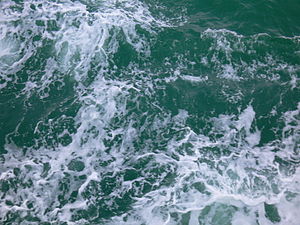
Did you know that the global population grows by 75 million people every year? This means that we will most likely go from 6.8 billion[1] people today to 9 billion by 2040.[2] In turn, this means that we may have to double our food production by 2050,[3] maybe more.
This is a problem. Our agriculture already uses 70% of all the available fresh water resources in the world and this goes up to 80% where the population growth is happening, i.e in the non-industrialized countries.[4] In other words, it isn’t obvious where we would find enough fresh water to double the agricultural output.
On top of the population growth we have: increased meat and dairy consumption, huge pollution problems from fertilizer and pesticide use, looming fossil fuel peaks – oil and coal is used to power the “green revolution” – competing biofuel production, desertification and climate change knocking on our door. The list goes on[5] (if you just visit one link, make it this one). All things which point to lower future food production, not higher.
Now what?
There isn’t one solution to our problems, but the Seawater Greenhouse may well be one of the most important innovations in agriculture in the last couple of decades. How does the following sound?
Grow food on otherwise unproductive land (read cheap), using only seawater, sunshine and nutrients as inputs.
So here is the deal: You need to find an arid location with access to seawater (or saline groundwater), think northern Africa, Namibia, Arab Peninsula, Mexico, California, Australia, Canary Islands, Chile and lots of other places. Find a place which is not too high above sea level to avoid pumping costs, where you can build your Seawater Greenhouse. The process in the greenhouse uses seawater to cool the greenhouse extremely energy efficiently using solar panels and cardboard evaporators, and creates a cool, humid environment – which the crop loves. Then the greenhouse takes the humidity out of the air with inexpensive plastic condensers and creates enough distilled water to grow your crops. The result is a greenhouse which allows you to grow any crop you like, including strawberries <grin>, in the dessert. The stable greenhouse climate will probably also make it easier to use biological control to deal with pests and diseases.[6]
So no use of fresh water, no fossil fuel, no (or less) pesticides, on otherwise completely unproductive land. This may well be the least environmentally damaging technology for agriculture we will have for the foreseeable future, which can scale massively.
Simply beautiful.
So what does the future look like?
The first commercial implementation is in progress in southern Australia as I write this.[7]
The Sahara Forest Project is looking towards large scale implementation of this in desert locations combined with concentrated solar power to bring food, energy and water from the desert.
In the future we can imagine building the greenhouse structure out of bamboo and having chicken and tilapia farms in combination with the greenhouse. Think: vegetable waste feeds chickens, the chickens’ waste feeds the duckweed in the ponds, the remaining vegetable waste becomes compost, the compost feeds worms, the worms and duckweed feed tilapia fish.
- ↑ U.S. Census Bureau, the total population of the World, projected to 06/30/10 at 20:54 UTC (EST+5) is 6,852,992,514, U.S. Census Bureau, http://www.census.gov/ipc/www/popclockworld.html retrieved on 30 June 2010.
- ↑ World Population,: 1950-2050, US Census Bureau, http://www.census.gov/ipc/www/idb/worldpopgraph.html retrieved on 30 June 2010.
- ↑ World must double food production by 2050: FAO chief, World Food Programme http://web.archive.org/web/20121005231227/http://www.wfp.org/content/world-must-double-food-production-2050-fao-chief retrieved on 30 June 2010.
- ↑ The United Nations World Water Development Report, World Water Assessment Programme, http://unesdoc.unesco.org/images/0012/001295/129556e.pdf, retrieved on 30 June 2010.
- ↑ Big Question: Feast or Famine? University of Minnesota, http://www.youtube.com/watch?v=F1IWkbU0SG4] retrieved on 2 January 2012.
- ↑ Desert makes seawater into freshwater (Woestijnkas maakt zout water zoet), EkoZine, Professor Joop van Lenteren, Wageningen University [http://www.ekozine.nl/load.php?naam=wie_wat_waar/wie_wat_waar.htm, retrieved on 30 June 2010.
- ↑ Disclosure: I work with Seawater Greenhouse Ltd. to bring desert grown food to your table.